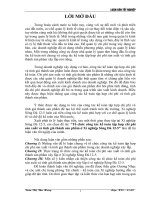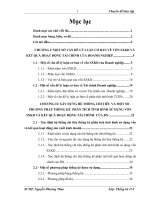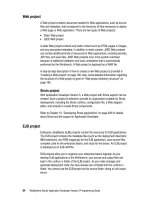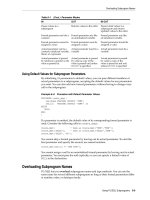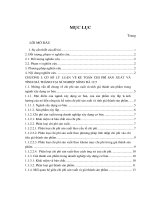PASCAL COMPATIBILITY GUIDE RELEASE 12 5 NVIDIA MAY 09, 2024
Bạn đang xem bản rút gọn của tài liệu. Xem và tải ngay bản đầy đủ của tài liệu tại đây (157.66 KB, 20 trang )
<span class="text_page_counter">Trang 1</span><div class="page_container" data-page="1">
<b>Pascal Compatibility Guide</b>
<i><b>Release 12.5</b></i>
<b>May 09, 2024</b>
</div><span class="text_page_counter">Trang 3</span><div class="page_container" data-page="3"><b>2 Application Compatibility on Pascal53 Verifying Pascal Compatibility for Existing Applications7</b>
3.1 Applications Using CUDA Toolkit 7.5 or Earlier . . . . 73.2 Applications Using CUDA Toolkit 8.0 . . . . 8
<b>4 Building Applications with Pascal Support9</b>
4.1 Applications Using CUDA Toolkit 7.5 or Earlier . . . . 94.2 Applications Using CUDA Toolkit 8.0 . . . . 10
6.1 Notice . . . . 156.2 OpenCL . . . . 166.3 Trademarks . . . . 16
<b>i</b>
</div><span class="text_page_counter">Trang 4</span><div class="page_container" data-page="4"><b>ii</b>
</div><span class="text_page_counter">Trang 5</span><div class="page_container" data-page="5"><b>Pascal Compatibility Guide, Release 12.5</b>
<b>Pascal Compatibility Guide for CUDA Applications</b>
The guide to building CUDA applications for GPUs based on the NVIDIA Pascal Architecture.
</div><span class="text_page_counter">Trang 6</span><div class="page_container" data-page="6"><b>Pascal Compatibility Guide, Release 12.5</b>
</div><span class="text_page_counter">Trang 7</span><div class="page_container" data-page="7">Chapter 1. About this Document
This application note, Pascal Compatibility Guide for CUDA Applications, is intended to help developersensure that their NVIDIA<small>®</small>CUDA<small>®</small>applications will run on GPUs based on the NVIDIA<small>®</small>Pascal Architec-ture. This document provides guidance to developers who are already familiar with programming inCUDA C++ and want to make sure that their software applications are compatible with Pascal.
<b>3</b>
</div><span class="text_page_counter">Trang 8</span><div class="page_container" data-page="8"><b>Pascal Compatibility Guide, Release 12.5</b>
<b>4Chapter 1. About this Document</b>
</div><span class="text_page_counter">Trang 9</span><div class="page_container" data-page="9">Chapter 2. Application Compatibility onPascal
The NVIDIA CUDA C++ compiler,<i>nvcc, can be used to generate both architecture-specific cubin filesand forward-compatible PTX versions of each kernel. Each cubin file targets a specific compute-capability version and is forward-compatible only with GPU architectures of the same major version</i>
<i>number. For example, cubin files that target compute capability 3.0 are supported on all </i>
<i>compute-capability 3.x (Kepler) devices but are not supported on compute-compute-capability 5.x (Maxwell) or 6.x (Pascal)</i>
devices. For this reason, to ensure forward compatibility with GPU architectures introduced after theapplication has been released, it is recommended that all applications include PTX versions of theirkernels.
<b>Note: CUDA Runtime applications containing both cubin and PTX code for a given architecture will</b>
automatically use the cubin by default, keeping the PTX path strictly for forward-compatibility poses.
pur-Applications that already include PTX versions of their kernels should work as-is on Pascal-based GPUs.Applications that only support specific GPU architectures via cubin files, however, will need to be up-dated to provide Pascal-compatible PTX or cubins.
<b>5</b>
</div><span class="text_page_counter">Trang 10</span><div class="page_container" data-page="10"><b>Pascal Compatibility Guide, Release 12.5</b>
<b>6Chapter 2. Application Compatibility on Pascal</b>
</div><span class="text_page_counter">Trang 11</span><div class="page_container" data-page="11">Chapter 3. Verifying Pascal
Compatibility for ExistingApplications
The first step is to check that Pascal-compatible device code (at least PTX) is compiled in to the cation. The following sections show how to accomplish this for applications built with different CUDAToolkit versions.
appli-3.1. Applications Using CUDA Toolkit 7.5 orEarlier
CUDA applications built using CUDA Toolkit versions 2.1 through 7.5 are compatible with Pascal aslong as they are built to include PTX versions of their kernels. To test that PTX JIT is working for yourapplication, you can do the following:
▶ Download and install the latest driver from Set the environment variableCUDA_FORCE_PTX_JIT=1.
▶ Launch your application.
When starting a CUDA application for the first time with the above environment flag, the CUDA driverwill JIT-compile the PTX for each CUDA kernel that is used into native cubin code.
If you set the environment variable above and then launch your program and it works properly, thenyou have successfully verified Pascal compatibility.
<b>Note: Be sure to unset the CUDA_FORCE_PTX_JIT environment variable when you are done testing.</b>
<b>7</b>
</div><span class="text_page_counter">Trang 12</span><div class="page_container" data-page="12"><b>Pascal Compatibility Guide, Release 12.5</b>
3.2. Applications Using CUDA Toolkit 8.0
CUDA applications built using CUDA Toolkit 8.0 are compatible with Pascal as long as they are built toinclude kernels in either Pascal-native cubin format (seeBuilding Applications with Pascal Support) orPTX format (seeApplications Using CUDA Toolkit 7.5 or Earlier) or both.
<b>8Chapter 3. Verifying Pascal Compatibility for Existing Applications</b>
</div><span class="text_page_counter">Trang 13</span><div class="page_container" data-page="13">Chapter 4. Building Applications withPascal Support
When a CUDA application launches a kernel, the CUDA Runtime determines the compute capability ofeach GPU in the system and uses this information to automatically find the best matching cubin orPTX version of the kernel that is available. If a cubin file supporting the architecture of the target GPUis available, it is used; otherwise, the CUDA Runtime will load the PTX and JIT-compile that PTX to theGPU’s native cubin format before launching it. If neither is available, then the kernel launch will fail.The method used to build your application with either native cubin or at least PTX support for Pascaldepend on the version of the CUDA Toolkit used.
The main advantages of providing native cubins are as follows:
▶ It saves the end user the time it takes to JIT-compile kernels that are available only as PTX. Allkernels compiled into the application must have native binaries at load time or else they will bebuilt just-in-time from PTX, including kernels from all libraries linked to the application, even ifthose kernels are never launched by the application. Especially when using large libraries, thisJIT compilation can take a significant amount of time. The CUDA driver will cache the cubinsgenerated as a result of the PTX JIT, so this is mostly a one-time cost for a given user, but it istime best avoided whenever possible.
▶ PTX JIT-compiled kernels often cannot take advantage of architectural features of newer GPUs,meaning that native-compiled code may be faster or of greater accuracy.
4.1. Applications Using CUDA Toolkit 7.5 orEarlier
The compilers included in CUDA Toolkit 7.5 or earlier generate cubin files native to earlier NVIDIA
<i>ar-chitectures such as Kepler and Maxwell, but they cannot generate cubin files native to the Pascal</i>
architecture. To allow support for Pascal and future architectures when using version 7.5 or earlier ofthe CUDA Toolkit, the compiler must generate a PTX version of each kernel.
Below are compiler settings that could be used to buildmykernel.cu to run on Kepler or Maxwelldevices natively and on Pascal devices via PTX JIT.
<b>Note:</b> compute_XX refers to a PTX version and sm_XX refers to a cubin version. The arch= clauseof the-gencode= command-line option to nvcc specifies the front-end compilation target and mustalways be a PTX version. Thecode= clause specifies the back-end compilation target and can either
<b>9</b>
</div><span class="text_page_counter">Trang 14</span><div class="page_container" data-page="14"><b>Pascal Compatibility Guide, Release 12.5</b>
be cubin or PTX or both. Only the back-end target version(s) specified by thecode= clause will beretained in the resulting binary; at least one must be PTX to provide Pascal compatibility.
nvcc.exe -ccbin "C:\vs2010\VC\bin"
-Xcompiler "∕EHsc ∕W3 ∕nologo ∕O2 ∕Zi ∕MT"-gencode=arch=compute_30,code=sm_30
--compile -o "Release\mykernel.cu.obj" "mykernel.cu"
-gencode=arch=compute_30,code=sm_30-gencode=arch=compute_35,code=sm_35-gencode=arch=compute_50,code=sm_50-gencode=arch=compute_52,code=sm_52-gencode=arch=compute_52,code=compute_52-O2 -o mykernel.o -c mykernel.cu
Alternatively, you may be familiar with the simplifiednvcc command-line option -arch=sm_XX, whichis a shorthand equivalent to the following more explicit-gencode= command-line options used above.-arch=sm_XX expands to the following:
However, while the -arch=sm_XX command-line option does result in inclusion of a PTX back-endtarget by default, it can only specify a single target cubin architecture at a time, and it is not possibleto use multiple-arch= options on the same nvcc command line, which is why the examples aboveuse-gencode= explicitly.
4.2. Applications Using CUDA Toolkit 8.0
With version 8.0 of the CUDA Toolkit,nvcc can generate cubin files native to the Pascal architectures(compute capability 6.0 and 6.1). When using CUDA Toolkit 8.0, to ensure thatnvcc will generate cubinfiles for all recent GPU architectures as well as a PTX version for forward compatibility with future GPUarchitectures, specify the appropriate-gencode= parameters on the nvcc command line as shown inthe examples below.
nvcc.exe -ccbin "C:\vs2010\VC\bin"
-Xcompiler "∕EHsc ∕W3 ∕nologo ∕O2 ∕Zi ∕MT"-gencode=arch=compute_30,code=sm_30
<small>(continues on next page)</small>
<b>10Chapter 4. Building Applications with Pascal Support</b>
</div><span class="text_page_counter">Trang 15</span><div class="page_container" data-page="15"><b>Pascal Compatibility Guide, Release 12.5</b>
<small>(continued from previous page)</small>-gencode=arch=compute_61,code=sm_61
<b>Note:</b> compute_XX refers to a PTX version and sm_XX refers to a cubin version. The arch= clauseof the-gencode= command-line option to nvcc specifies the front-end compilation target and mustalways be a PTX version. Thecode= clause specifies the back-end compilation target and can either becubin or PTX or both. Only the back-end target version(s) specified by thecode= clause will be retainedin the resulting binary; at least one should be PTX to provide compatibility with future architectures.
<b>4.2. Applications Using CUDA Toolkit 8.011</b>
</div><span class="text_page_counter">Trang 16</span><div class="page_container" data-page="16"><b>Pascal Compatibility Guide, Release 12.5</b>
<b>12Chapter 4. Building Applications with Pascal Support</b>
</div><span class="text_page_counter">Trang 17</span><div class="page_container" data-page="17">Chapter 5. Revision History
</div><span class="text_page_counter">Trang 18</span><div class="page_container" data-page="18"><b>Pascal Compatibility Guide, Release 12.5</b>
</div><span class="text_page_counter">Trang 19</span><div class="page_container" data-page="19">Chapter 6. Notices
6.1. Notice
This document is provided for information purposes only and shall not be regarded as a warranty of acertain functionality, condition, or quality of a product. NVIDIA Corporation (“NVIDIA”) makes no repre-sentations or warranties, expressed or implied, as to the accuracy or completeness of the informationcontained in this document and assumes no responsibility for any errors contained herein. NVIDIA shallhave no liability for the consequences or use of such information or for any infringement of patentsor other rights of third parties that may result from its use. This document is not a commitment todevelop, release, or deliver any Material (defined below), code, or functionality.
NVIDIA reserves the right to make corrections, modifications, enhancements, improvements, and anyother changes to this document, at any time without notice.
Customer should obtain the latest relevant information before placing orders and should verify thatsuch information is current and complete.
NVIDIA products are sold subject to the NVIDIA standard terms and conditions of sale supplied at thetime of order acknowledgement, unless otherwise agreed in an individual sales agreement signed byauthorized representatives of NVIDIA and customer (“Terms of Sale”). NVIDIA hereby expressly objectsto applying any customer general terms and conditions with regards to the purchase of the NVIDIAproduct referenced in this document. No contractual obligations are formed either directly or indirectlyby this document.
NVIDIA products are not designed, authorized, or warranted to be suitable for use in medical, military,aircraft, space, or life support equipment, nor in applications where failure or malfunction of the NVIDIAproduct can reasonably be expected to result in personal injury, death, or property or environmentaldamage. NVIDIA accepts no liability for inclusion and/or use of NVIDIA products in such equipment orapplications and therefore such inclusion and/or use is at customer’s own risk.
NVIDIA makes no representation or warranty that products based on this document will be suitable forany specified use. Testing of all parameters of each product is not necessarily performed by NVIDIA.It is customer’s sole responsibility to evaluate and determine the applicability of any information con-tained in this document, ensure the product is suitable and fit for the application planned by customer,and perform the necessary testing for the application in order to avoid a default of the application orthe product. Weaknesses in customer’s product designs may affect the quality and reliability of theNVIDIA product and may result in additional or different conditions and/or requirements beyond thosecontained in this document. NVIDIA accepts no liability related to any default, damage, costs, or prob-lem which may be based on or attributable to: (i) the use of the NVIDIA product in any manner that iscontrary to this document or (ii) customer product designs.
No license, either expressed or implied, is granted under any NVIDIA patent right, copyright, or otherNVIDIA intellectual property right under this document. Information published by NVIDIA regardingthird-party products or services does not constitute a license from NVIDIA to use such products or
<b>15</b>
</div><span class="text_page_counter">Trang 20</span><div class="page_container" data-page="20"><b>Pascal Compatibility Guide, Release 12.5</b>
services or a warranty or endorsement thereof. Use of such information may require a license from athird party under the patents or other intellectual property rights of the third party, or a license fromNVIDIA under the patents or other intellectual property rights of NVIDIA.
Reproduction of information in this document is permissible only if approved in advance by NVIDIAin writing, reproduced without alteration and in full compliance with all applicable export laws andregulations, and accompanied by all associated conditions, limitations, and notices.
THIS DOCUMENT AND ALL NVIDIA DESIGN SPECIFICATIONS, REFERENCE BOARDS, FILES, DRAWINGS,DIAGNOSTICS, LISTS, AND OTHER DOCUMENTS (TOGETHER AND SEPARATELY, “MATERIALS”) AREBEING PROVIDED “AS IS.” NVIDIA MAKES NO WARRANTIES, EXPRESSED, IMPLIED, STATUTORY, OROTHERWISE WITH RESPECT TO THE MATERIALS, AND EXPRESSLY DISCLAIMS ALL IMPLIED WAR-RANTIES OF NONINFRINGEMENT, MERCHANTABILITY, AND FITNESS FOR A PARTICULAR PURPOSE.TO THE EXTENT NOT PROHIBITED BY LAW, IN NO EVENT WILL NVIDIA BE LIABLE FOR ANY DAMAGES,INCLUDING WITHOUT LIMITATION ANY DIRECT, INDIRECT, SPECIAL, INCIDENTAL, PUNITIVE, OR CON-SEQUENTIAL DAMAGES, HOWEVER CAUSED AND REGARDLESS OF THE THEORY OF LIABILITY, ARIS-ING OUT OF ANY USE OF THIS DOCUMENT, EVEN IF NVIDIA HAS BEEN ADVISED OF THE POSSIBILITYOF SUCH DAMAGES. Notwithstanding any damages that customer might incur for any reason whatso-ever, NVIDIA’s aggregate and cumulative liability towards customer for the products described hereinshall be limited in accordance with the Terms of Sale for the product.
©2016-2024, NVIDIA Corporation & affiliates. All rights reserved
</div>